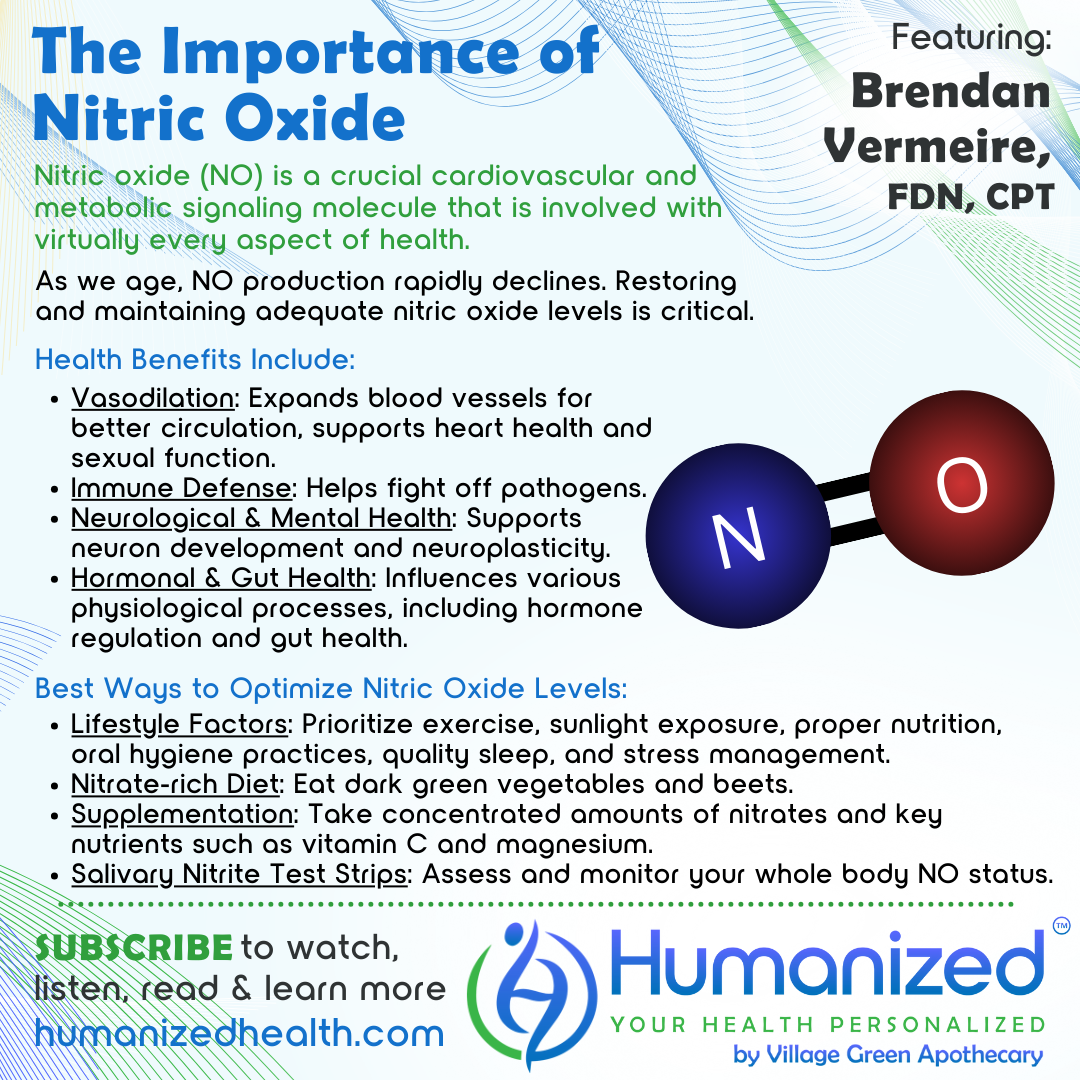Understanding Nitric Oxide
Featuring
Brendan Vermeire, FDN, CPT
WATCH
LISTEN
READ
Rebekah Kelley: Welcome to the Humanized Podcast, all about personalizing your health. I’m your host, Rebekah Kelly. And today our topic will be “Understanding Nitric Oxide” with functional medicine consultant, Brendan Vermeire. Before I introduce Brendan, I want to remind everyone to subscribe and get all the other variety of casts and audio/video and transcription at HumanizedHealth.com.
I’d also like to thank our lead sponsor Village Green Apothecary at myvillagegreen.com. A little bit about Brendan, he is a functional medicine consultant, clinical researcher, board certified holistic health practitioner, master nutrition coach, master personal trainer, USAW sports performance coach, and CrossFit certified trainer.
Brendan has been regarded as one of the top leading experts in metabolic health and holistic education. He’s the proud owner of Metabolic Solutions Institute, dedicated to educating health professionals and clinicians with cutting edge strategies to best serve their clients and their patients.
Thanks for being with us, Brendan.
Brendan Vermeire: Thanks for having me back, Rebekah. It’s good to talk to you all again.
Rebekah Kelley: It’s always a pleasure. I’m so interested in where you’re going to take us with this topic. So if you can just start by explaining to us what exactly is nitric oxide, assuming it’s not laughing gas, right? So what is it?
Brendan Vermeire: Yeah, absolutely. It’s a big subject and one that is really endlessly fascinating, and I’ve had the opportunity recently to just get more heavily involved in the nitric oxide research and development space, which has been really exciting because I’ve been familiar with nitric oxide my whole career. But, the science has evolved quite a bit, even just within the past, you know, 20-ish years. So, excited to dive into that a little bit, but from the top, nitric oxide–back in 1992–was really proclaimed molecule of the year. And it actually won the Nobel Prize in physiology for these three scientists that really discovered this nitric oxide molecule as being a crucial signaling molecule within the cardio metabolic system. And it’s really regarded as one of the greatest accomplishments in cardiovascular, cardiometabolic medicine.
So ultimately, nitric oxide, it’s a gas and it has a half life of like three milliseconds, right? And when you start digging into all the cool science on nitric oxide, it really is impacting virtually every aspect of our physiology and biochemistry. Honestly, at this point in time, at this point in my career, I don’t know of another signaling molecule that really pulls as much weight as nitric oxide. It’s so deeply implicated and involved with every aspect of our health. So there’s so many different mechanisms and there is–just to kind of kick us off on the right foot–there is a dual role.
So when you dig into the literature, there’s a lot of literature that really gives nitric oxide credit as being very healing and very health-promoting, but there’s kind of a dark side to nitric oxide, too, of too much nitric oxide under certain conditions can actually exacerbate disease and oxidative stress and inflammation. So it becomes this very complex and nuanced subject that goes down all sorts of cool rabbit holes, but that’s a little bit of a cliff notes there.
Rebekah Kelley: I like it. I like how you oriented us. And as anything, right? Like there is a certain place where something becomes not a good fit for your body, right? So you’re going to help us, I guess, understand that balance, right? So what are the health benefits? What does that balance look like?
Brendan Vermeire: Yeah. So nitric oxide, typically, the people that know about nitric oxide, they’re really thinking about vasodilation and blood flow. You know, that is the classic sort of ideology and mechanism behind nitric oxide is this transient gas that’s essentially going to cause an expansion of our blood vessels. You know, this vasodilation it causes smooth muscle relaxation within the endothelial lining of our blood vessels.
So typically it’s very much thought of in regards to heart health or sexual function, like erectile dysfunction. We’re thinking of nitric oxide and vasodilation, right? But it’s so much more than that. We actually use nitric oxide as part of our immune defense. We can fight off pathogens. It’s deeply involved with every aspect of our neurological and mental health where it actually helps to take neural stem cells. And cause the maturation and the integration of those young neurons into our existing neural circuitry. It regulates neurotransmission and acts as a neurotransmitter itself, regulating neuroplasticity. And this is so deeply involved in neurology and mental health, sexual health, hormone health, immune health, gut health, I mean, virtually everything.
So, all of us, anybody that is human, we have to have plenty of nitric oxide availability and signaling all day, every day. And certainly when things start going wrong, you know, health implications can arise.
Rebekah Kelley: So obviously nitric oxide production, being at its optimum, is going to be what you need for vital health is what I hear you saying, right? So how can we then optimize this? How do we know that we’re getting it the right way and we’re not creating problems for ourselves?
Brendan Vermeire: Yeah, absolutely. So this is where the conversation is expanding, you know, back when I was 18-years-old, I was working at GNC. I was really, really into bodybuilding at that point in my life, I had been an athlete forever. So in the sports performance, kind of “fitness junkie world,” we think of nitric oxide as “train harder, train longer, recover faster, increase blood flow” and the muscle pump we get in the gym when we’re lifting weights or whatever. Or if you’re an endurance athlete, you can train longer, harder, faster, increasing your volume of oxygen consumption, because of the role nitric oxide is playing with blood flow and oxygenation to the tissues.
So, in the sports performance world, everybody is using some type of kind of nitric oxide promoting supplement. Basically, every pre-workout formula that exists has different types of substrates to produce nitric oxide. So, classically, the way that the body produces nitric oxide is through the nitric oxide synthase pathway. And we have three different isoforms of this enzyme. We have neuronal nitric oxide synthase. So this is the variation of the enzyme that our brain cells and cells within the central nervous system express more so for its role as a signaling molecule within our nervous system. Then we have the endothelial nitric oxide synthase, which is the isoform within the endothelial lining of our blood vessels and lymphatic vessels, which nobody ever talks about. But then we have inducible nitric oxide synthase, which is expressed by immune cells such as microglial cells in the brain or macrophages in the periphery. And the immune cells are more so using the nitric oxide as an antimicrobial gas to kill off foreign invaders and pathogens, right?
So, it’s exciting where nitric oxide kind of takes me back to the origins of my career as more fitness-related, nutrition and performance. But where the conversation is now expanding, based on the literature that has come out within the past, like 10 to 15 years is there’s this other pathway that was previously not known and not appreciated, which actually, as the research expands, it seems like this is more our main mechanism to supply the body with nitric oxide. And so where we have this endogenous enzyme-driven nitric oxide synthase pathway, we’re now really starting to see that this nitrate pathway is actually much more powerful, it seems to be more ancient and primordial. Where one could argue that this is a mechanism by which our microbiome, our garden of life, is really what’s supplying the majority of nitric oxide in the body, and essentially the way that that works, is we consume dietary nitrate, NO3, right? Consuming nitrate from dark green leafy things, you know, your spinach, bok choy, arugula, beets are a big source of dietary nitrate. Certainly there’s a conversation to be had about soil quality and nitrate concentration in our produce, but just to keep it simple and straightforward, you know, our plant food and plant matter coming out of the ground that supplies the dietary nitrate. And then that NO3 nitrate can be reduced to nitrite and then nitric oxide, which is largely regulated by the oral microbiome, the acidic stomach environment, and then the gastrointestinal microbiome.
So we really have these two different pathways that we can leverage for adequate nitric oxide bioavailability. And certainly we can dig into this more because the nitrate pathway seems to be basically the best way to go and the more sort of biologically sound way to go. Because there are a lot of problems that can arise with the nitric oxide synthase pathway, and we see this with chronic disease of any kind, inflammatory disease, and the aging process. Our body’s endogenous nitric oxide synthase pathway starts shutting down more and more and more as we age and as inflammation goes up. So we have to be leveraging this extra nitrate pathway to really circumvent that issue.
Rebekah Kelley: So what are the things that we can do? Is it only like a supplement? Is it like, almost everyone seems to be like exercise helps. What are the things to do for us to optimize? What are the activities? Is it a lifestyle? I mean, I know you’re not diving necessarily into the vegetable quality, but I think we kind of know, right? Like you do need quality in order– if you’re going to do it from a diet perspective, but what are the things that people would need to do to make sure that their nitric oxide levels are at optimum? And also, can you test for this?
Brendan Vermeire: Oh, for sure. I mean, there’s a lot to unpack there. And obviously a lot of the work that I do is kind of looking at the mechanism of action of whether it’s a drug and a pharmaceutical or a nutraceutical or a botanical, whatever, but really looking at the deep mechanisms on a cellular physiological biochemical level, but then a huge part of what I try to do is then translate that and sort of reverse engineer that back to holistic lifestyle foundations, right?
Because the idea of like, let’s say you take standard American metabolism, somebody that’s metabolically ill, chronic inflammation-based disease, whether it’s diabetes, heart disease, cerebrovascular, whatever the issue is, right? It wouldn’t make sense to take somebody like that and simply say, well, you just need this supplement that the mechanism is to boost nitric oxide.
Now, I say that, and this is exactly what big pharma does, the big pharma business models– let’s take that sickly physiological milieu and then just simply put in these specific drugs and pills that have this specific mechanism of actions. Like, well, that’s not the problem. The problem is the lifestyle and environmental foundations are causing all of these input signals that are dysregulating the body’s physiology that drives disease. So the ultimate solution is environment and lifestyle primarily, the body operates on this principle specific adaptation to impose demand. So if we want a different health outcome, we have to change the input signals through the environment and lifestyle primarily. Now with boosting nitric oxide signaling and bioavailability. Yeah, exercise, activity, sunlight, or light therapy, and we’re just talking about light therapy a second ago, right? So, modifying the input signals of movement, nutrition, air quality, light therapy, sleep, stress management, like, if you really apply yourself to the lifestyle foundations, that will mechanistically, dramatically improve nitric oxide signaling in the body.
However, ultimately, though, we still have to get specific nutrients to feed either the nitric oxide synthase pathway, we have to eat enough proteins, we’re able to manufacture arginine and citrulline that drive the nitric oxide synthase pathway, along with a lot of cofactors and coenzymes are needed to catalyze this enzymatic reaction. Things like biopterin and NADPH and a lot of B vitamins, magnesium, glutathione. If we have any sort of genetic inhibition of that enzyme, if we lack substrate, if we lack cofactors and coenzymes, we’re not going to be able to properly make that nitric oxide molecule. And then on the nitrate pathway side, we really have to be thinking about dietary nitrate as an essential nutrient. I think it’s probably just a matter of time before it is considered an essential nutrient. But this is relatively young, new science within the past like 10 to 15 years. So we’re kind of on the precipice of this taking off.
Rebekah Kelley: Is there a test that one can find out? Okay.
Brendan Vermeire: Yeah. There’s a number of blood biomarkers that we can use to infer the likelihood of nitric oxide dysregulation. You can’t measure nitric oxide directly in the blood because it has a half life of like three milliseconds. You can measure nitrite, nitrate in the blood or other kinds of surrogate biomarkers. But really the best way to go is using salivary nitrite test strips because we actually concentrate the majority of our body’s nitrate into the salivary glands. And as soon as that saliva is spit and sort of inserted into the oral microbiome cavity, that actually will reduce to nitrite, which is what the strips are measuring. So it’s probably the best, most convenient, noninvasive way to really get an insight into your whole body nitric oxide status.
Rebekah Kelley: Very cool. So what haven’t I asked you that I should have asked you?
Brendan Vermeire: Well, the thing that we like to talk about a lot with nitric oxide therapeutic strategies is it’s going to enhance the outcome of whatever that person is doing. Whether they’re doing more of a diet-nutrition based program or an exercise program or holistic lifestyle coaching, or a lot of pharmaceuticals or peptides. Whatever they’re doing, we can enhance the outcome because we’re boosting nitric oxide signaling and bioavailability, which is touching, positively influencing, every other aspect of our physiology. In a lot of ways, these other therapeutics, while they might be helpful in certain aspects of our health, if the foundation’s not there because we don’t have healthy nitric oxide signaling, those other compounds or strategies and interventions are only really going to do so much. So that’s why we’re so passionate about promoting healthy lifestyle foundations and promoting the increased efficacy of every other intervention by boosting nitric oxide signaling.
Rebekah Kelley: I love that. Thanks, Brendan.
These are really valuable insights. Brenda Vermeire can be found at www.MetabolicSolutionsLLC.com. Let me remind you to subscribe and get access to all Humanized videos, podcasts, and transcriptions from all our thought leaders on personalized health at HumanizedHealth.com. Please come back Brendan.
Brendan Vermeire: Absolutely.









